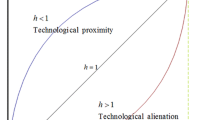Abstract
In this paper we consider a Cournot duopoly model to examine the effects of licensing on R&D organization. When firms do cooperative R&D to share the cost of R&D, possibility of licensing can influence the decision on R&D organization. But, if the firms do cooperative R&D to avoid duplication in R&D process, possibility of licensing may influence the decision on R&D organization, provided one firm behaves like a Stackelberg leader in the product market.
Similar content being viewed by others
References
Aghion, P. and J. Tirole. (1994). “The Management of Innovation,” Quarterly Journal of Economics 109, 1185–1209.
Choi, J. P. (1993). “Cooperative R&D With Product Market Competition,” International Journal of Industrial Organization 11, 553–571.
Combs, K. L. (1992). “Cost Sharing vs. Multiple Research Project in Cooperative R&D,” Economics Letters 39, 353–357.
Combs, K. L. (1993). “The Roles of Information Sharing in Cooperation, Research and Development,” International Journal of Industrial Organization 11, 535–551.
Dasgupta, S. and Z. Tao. (1998). “Contractual Incompleteness and the Optimality of Equity Joint Ventures,” Journal of Economic Behavior And Organization 37, 391–413.
d'Aspremont, C. and A. Jaquemin. (1988). “Cooperative and Non-Cooperative R&D in Duopoly with Spillovers,” The American Economic Review 78, 1133–1137.
Gallini, N. T. (1984). “Deterrence Through Market Sharing: A Strategic Incentive for Licensing,” The American Economic Review 74, 931–941.
Gallini, N. T. and R. A. Winter. (1985). “Licensing in the Theory of Innovation,” RAND Journal of Economics 16, 237–252.
Grossman, S. J. and O. D. Hart. (1986). “The Costs and Benefits of Ownership: A Theory of Vertical and Lateral Integration,” Journal of Political Economy 94, 691–719.
Kamien, M., E. Muller, and I. Zang. (1992). “Research Joint Ventures and R&D Cartels,” The American Economic Review 82, 1293–1306.
Katz, M. (1986). “An Analysis of Cooperative Research and Development,” RAND Journal of Economics 17, 527–543.
Katz, M. L. and C. Shapiro. (1985). “On the Licensing of Innovations,” RAND Journal of Economics 16, 504–520.
Marjit, S. (1990). “On a Non-Cooperative Theory of Technology Transfer,” Economics Letters 33, 293–298.
Marjit, S. (1991). “Incentives for Cooperative and Non-Cooperative R&D in Duopoly,” Economics Letters 37, 187–191.
Marjit, S. (1994) “Verification and Adverse Selection-A Case of Corruption in Public Procurement,” Working paper.
Marjit, S. and H. L. Shi. (1995). “Non-Cooperative, Cooperative and Delegative R&D,” Group Decision and Negotiation 4, 401–409.
Mukherjee, A. (2001). “Technology Transfer with Commitment,” Economic Theory 17, 345–369.
Mukherjee, A. and S. Marjit. (2001). “R&D Organization and Technology Transfer,” Working Paper Series, No. 2001/03, Department of Economics, Keele University.
Motta, M. (1992). “Cooperative R&D and Vertical Product Differentiation,” International Journal of Industrial Organization 10, 643–661.
Salant, S. (1984). “Preemptive Patenting and the Persistence of Monopoly: Comment,” The American Economic Review 74, 247–250.
Silipo, D. B. (1994). “Cooperative and Non-Cooperative R&D with Uncertainty and Spillovers,” Discussion papers in Economics, No. 94/13, University of York.
Suzumura, K. (1992). “Cooperative and Non-Cooperative R&D in Duopoly with Spillovers,” The American Economic Review 82, 1307–1320.
Tirole, J. (1986). “Hierarchies and Bureaucracies: On the Role of Collusion in Organizations,” Journal of Law, Economics and Organization 2, 181–214.
Wang, X. H. and B. Yang. (1999). “On Licensing under Bertrand Competition,” Australian Economic Papers 38, 106–119.
Author information
Authors and Affiliations
Rights and permissions
About this article
Cite this article
Mukherjee, A., Marjit, S. R&D organization and technology transfer. Group Decision and Negotiation 13, 243–258 (2004). https://doi.org/10.1023/B:GRUP.0000031079.32373.a4
Issue Date:
DOI: https://doi.org/10.1023/B:GRUP.0000031079.32373.a4



